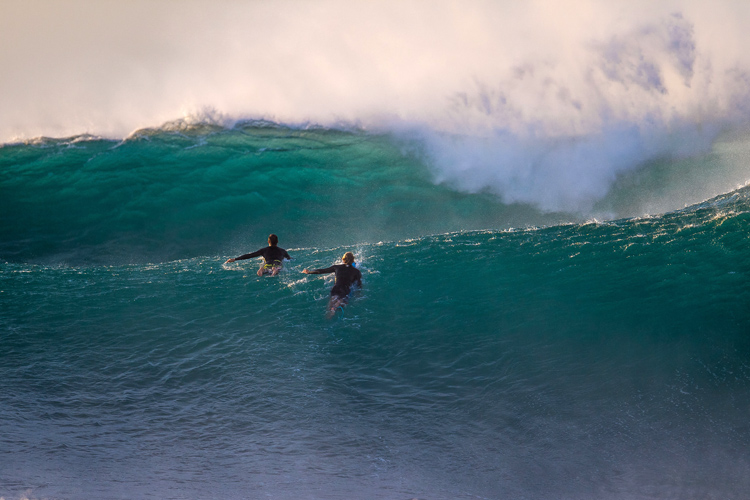You can't be a good surfer if you don't use your grey matter. Here's why intelligence is a powerful weapon in the waves.
Although surfing sounds pretty much like physical and technical outdoor activity, intelligence plays a critical role in the development of the skills and the performance you actually achieve in the waves.
There is a lot of theory and method in surfing as a high-performance sport, and it's been scientifically proven that learned knowledge is linked to the enhancement of sports practice.
Intelligence is putting education, experience, decision-making, problem-solving, real-time processing ability, and behavior to work.
The highest form of thinking enhances the surfer's activity.
Let's not forget that the sport of surfing is intrinsically connected with other human sciences like oceanography, physics, meteorology, hydrodynamics, and biology.
Surf books are always a great way to start.
They compile a lot of valuable information about the variables related to surfing, but they also detail and share precious experiences lived by other wave riders.
Let's see how intelligence will make you a better surfer:
Analyzing the Forecast
Knowing when to go is a useful weapon. Can you read a simple wind and wave forecast?
Are you able to identify the best swell angles for your favorite surf breaks? Do you understand the basics behind weather charts?
Do you know the difference between a groundswell and a wind swell and how both impact the wave conditions at your local beach?
The surf forecast is a powerful weapon that, if used correctly, will let you know where and when it's pumping.
Choosing the Right Spot
Now that you possess all the data, it's time to decide if you should head north, south, west, or east. Decisions based solely on instinct rarely work.

Reading the Real-Time Conditions
Once you arrive at the beach, there's a lot to look at.
You have to wait a few minutes and analyze each wave and each set and then compare them to the next ones. Just because there are waves, it doesn't mean they are good enough.
Before jumping in your wetsuit, analyze all the variables and decide whether it's worth staying or if you should check a nearby spot.
Paddling Out at the Ideal Tide Time
Surf spots are sensitive ecosystems. Subtle changes in the wind can dramatically change the breaking of the waves.
And when you add tides into the equation, then everything changes even more.
Some breaks work better in low tides; others will only deliver pristine conditions on mid-to-low or mid-to-high tides.
Understanding the "Rule of Twelfths" will increase your chances of scoring the best possible waves.
Selecting the Optimal Peak
It is one of surfing's classic dilemmas. Should you paddle out to the best peak, where it's crowded, or is it better to surf not-so-good waves in a less populated lineup?
Don't follow the flock. Find out an alternative wave peak - surf more waves, and have more fun, even if it means sacrificing quality. That's always the wisest move.
Positioning in the Lineup
Triangulation is one of the most underrated skills in surfing.
There's a huge difference between sitting exactly where the wave breaks and waiting for the set a couple of yards left, right, in, or out.
Depending on the behavior of the wave, you'll need to adjust your position in the lineup to get the best rides.
Look for landmarks, cliffs, and characteristic natural settings to know where you are and where you should be.

Picking the Best Waves
You are waiting for the set, and when it arrives, traveling fast on the horizon, you've got to make quick decisions. But how do you know which wave to pick?
There's a rule of thumb that tells us that we should never paddle into the first wave of a set.
Why? Because sometimes, the first wave carries more water than the next rollers and because, quite often, everyone tends to lose their patience and paddle immediately for the first wave.
Reading the Flow of the Wave
A beginner surfer will never become an intermediate and advanced surfer without knowing how to read a wave properly. And that sometimes also involves learning the basics of bathymetry.
A perfect wave is a wave that breaks and peels relatively steadily down the line, from one side to another, allowing surfers to ride its open, unbroken face. That's what surfing is all about.
Knowing When to Paddle In
Surfing can be an addiction. But sometimes, we must know when it's time to stop and rest.
Don't drain all your energy while you're still out the back.
You may need an extra push to battle a tricky current, so make sure there's enough gas left in the tank to get back to shore.
Finally, and especially in extreme wave conditions, make sure you're feeling psychologically comfortable and physically strong to tackle unexpected beatings and challenging duck dives.
Words by Luís MP | Founder of SurferToday.com
